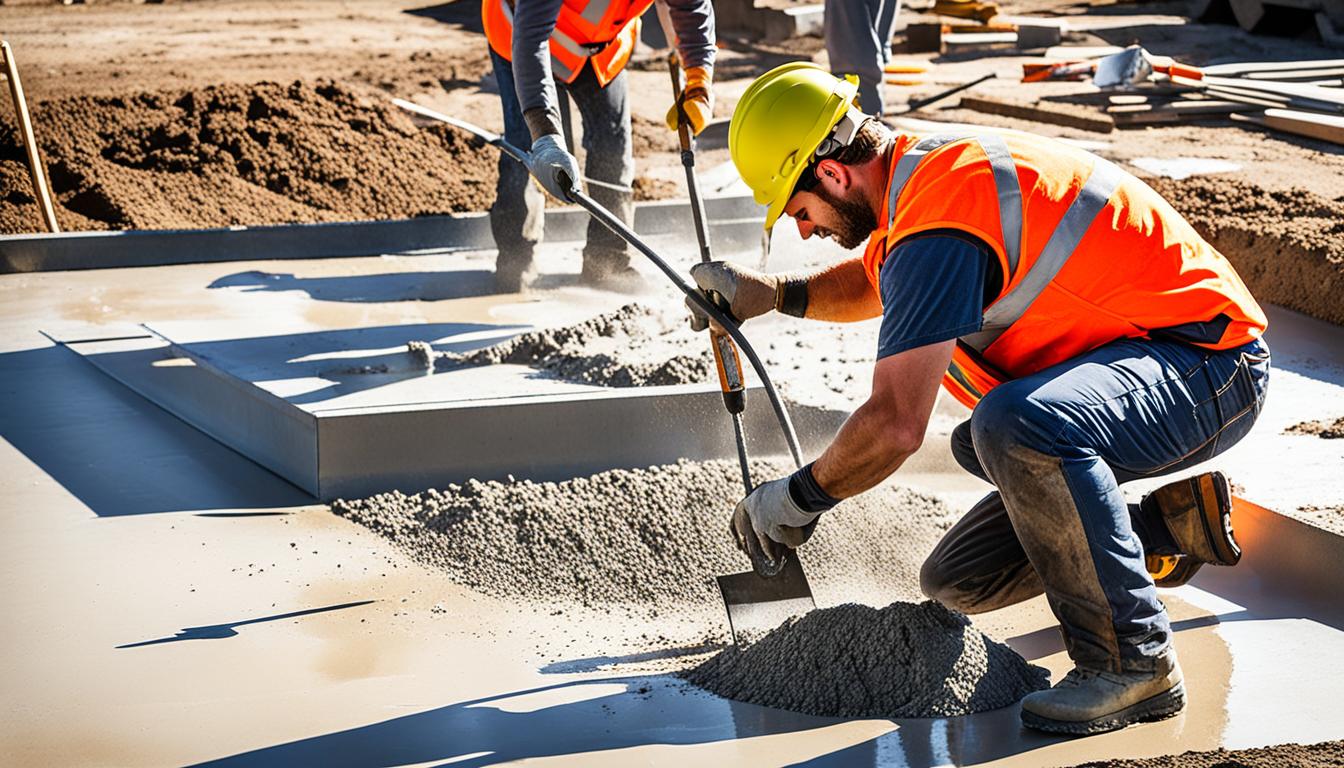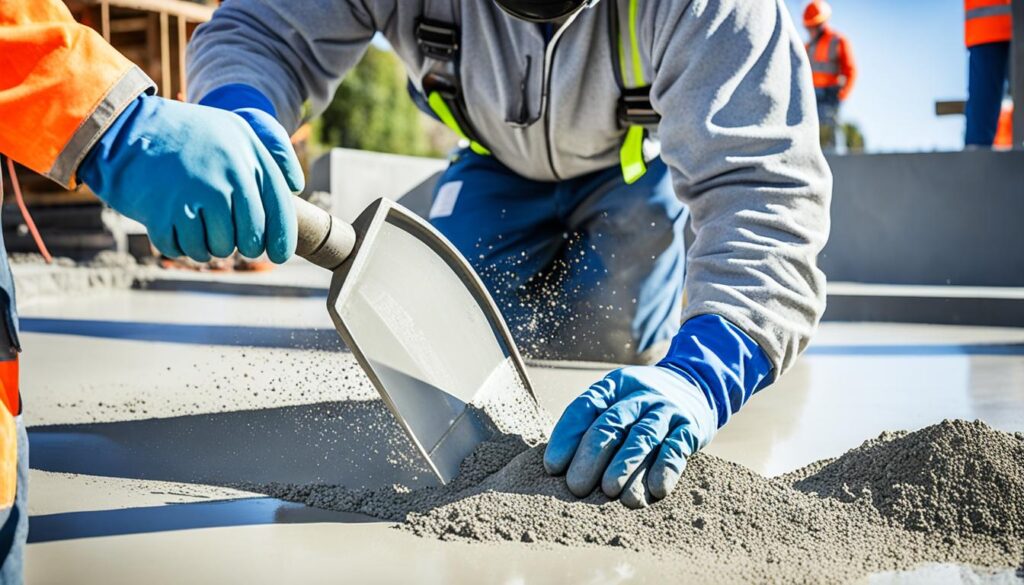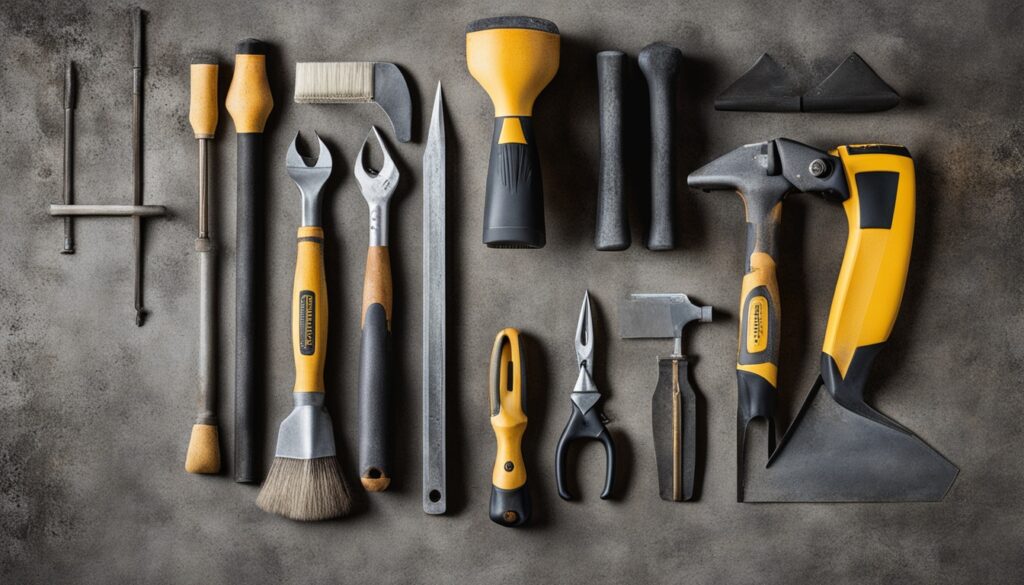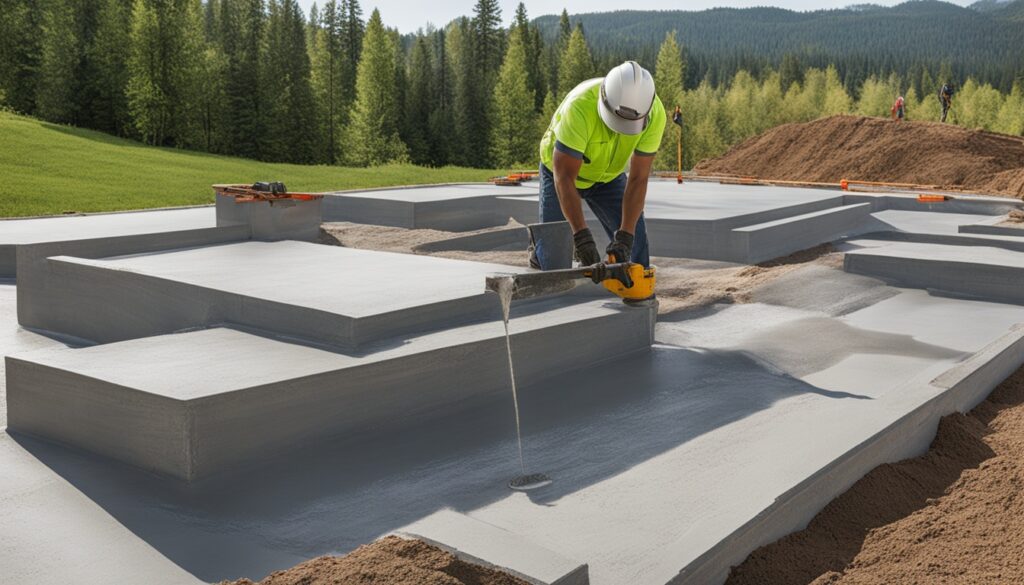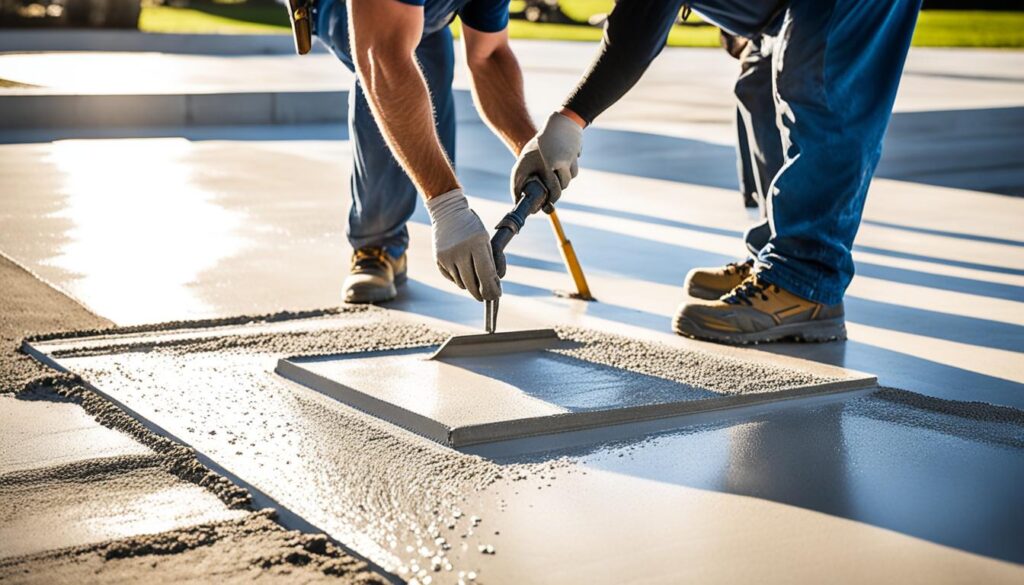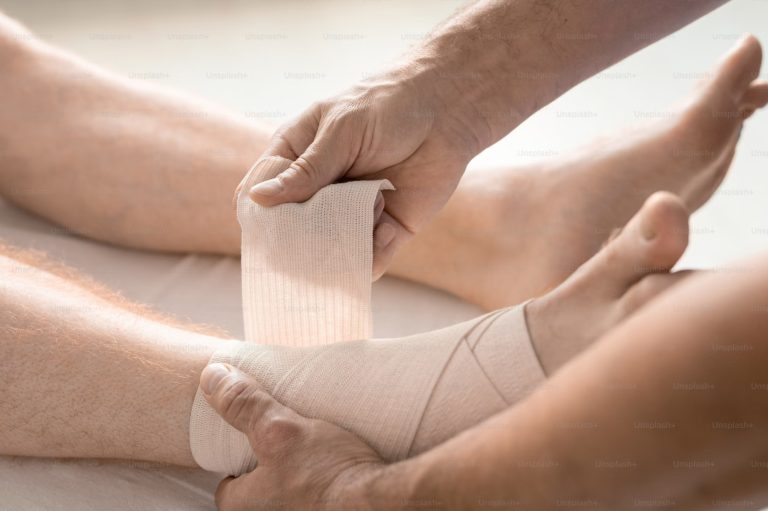Mastering the Art of Working on Concrete: A Guide
Concrete is key in building work. It’s important to know how to use it right. Our guide dives deep into working on concrete. It gives you the need-to-know info and skills for concrete construction, concrete pouring, concrete finishing, and more.
This guide is all about the role of concrete in building. It talks about the tough parts of working with concrete. It also covers what tools and equipment you need for concrete work. Get ready for how to mix, pour, finish, and cure concrete.
We also look at keeping safe, fixing, and improving concrete work. You’ll learn about cool decorative concrete styles and specialty concrete mixes too. This guide makes learning about working on concrete fun and easy. You’ll be better at your projects in no time.
Introduction to Working on Concrete
Concrete is important in construction work. It is used to make the base for buildings and big projects. Concrete is strong and lasts long, making it key in building things that stand tall and last for many years. It’s also used for walls and parts that hold the building steady.
Importance of Concrete in Construction
Concrete stands as the key in building from homes to huge towers. It resists being squished and can be shaped easily. These perks give it a special place for those creating buildings and bridges. Adding to this, it’s tough against fire and doesn’t need much care after it’s set.
Challenges of Working with Concrete
Though concrete is handy, using it has its hurdles. Making sure it’s mixed, poured, and dried right is key. Working with concrete can mean moving heavy stuff and a lot of sweat. Safety, weather, and team work need close attention too.
Essential Tools for Concrete Work
To do concrete jobs, you need lots of power tools and gear. You must have concrete mixers, power trowels, and concrete vibrators. These help mix, finish, and shape the concrete.You’ll also use power saws to cut concrete. And for making it smooth or shiny, power grinders and polishers come in handy.
Power Tools and Equipment
Besides power tools, you’ll need hand tools too. Tools like trowels, floats, and edgers shape and smooth the concrete. You must also have shovels, wheelbarrows, and buckets for moving the concrete mix. Tools for measuring, such as tape measures and levels, make sure everything is just right.
Hand Tools and Accessories
This guide tells you exactly how to use tools like screeds and floats.It says the right time to use each one for the best results. Tools listed include Magnesium Bull Floats and All Steel Groovers. They help get the job done well.
Concrete Mixing and Pouring Techniques
First, we need to get the worksite ready before any concrete work starts. This means clearing away any debris and making sure the ground is firm and flat. We also set up any forms or iron we need. Getting the site ready well makes sure the foundation is strong and the pouring goes smoothly.
Mixing Concrete Properly
Mixing the concrete right is very important. You have to measure the cement, gravel, and water carefully. Then, you mix it all well so it’s just the right thickness.Good mixing means the concrete will be strong enough and easy to work with for the job.
Pouring and Leveling Concrete
Now, pouring and leveling the concrete takes focus. You pour the concrete slowly and evenly to prevent any bubbles. This makes the surface flat and smooth.We use tools like screeds and power trowels to level it. These make sure our foundation is even and ready for building.
Concrete Finishing and Curing
After pouring the concrete, we use different techniques for the look and feel you want. This can be troweling, brooming, or stamping. Each method offers a unique finish. The right choice depends on what the project needs and its look.
Finishing Techniques
Troweling makes the surface smooth with a steel trowel. It’s great for a clean, even appearance. Brooming, however, adds texture and grip with a broom. This finish is good for outside spaces.Stamping gives a decorative touch by pressing designs into the concrete.
Curing Methods
To make the concrete strong and long-lasting, curing is key. This means keeping it moist and at the right temperature for a while. We use methods like wet curing, curing compounds, or covering it with plastic. This stops the concrete from cracking or shrinking as it dries.
For the best strength, concrete should cure for at least seven days at temperatures above 40 degrees Fahrenheit. But, the time can change based on the cement type. For example, Type I cement might take seven days, while Type IV or V could need 14. Lower temperatures slow down how fast the concrete gets strong. If it’s 50 degrees Fahrenheit, it will strengthen half as fast as it would at 73.
Proper curing ensures the concrete is strong and durable. This is vital for any concrete project to be a success and last a long time.
Working on Concrete: Safety Considerations
Our safety is very important when working with concrete. PPE, like hard hats, safety goggles, and gloves, is a must.It protects us from harm and lets us do our work safely.
Personal Protective Equipment
Construction sites require hard hats to keep our heads safe.Safety goggles are vital too. They protect our eyes from concrete dust, which is harmful.
We also need special boots and gloves to prevent skin problems from concrete chemicals.And, masks are needed to keep our lungs safe from dust.
Site Safety Protocols
Using PPE is just the start. We must follow proper safety steps. This includes good teamwork, securing work areas, and obeying safety laws.
Keeping the site clean and knowing the dangers makes everyone safer.
Concrete is used to build many things, like roads and patios. But, it can cause health issues.Wear the right gear to avoid skin, eye, and lung problems.
Using wheelbarrows can hurt us, so it’s better to use special trucks for mixing and moving concrete safely.Keep concrete off your skin and clothes, and wash it off right away if it gets on your skin or eyes.Hiring professionals for concrete work is safer and cleaner.
Concrete Repair and Resurfacing
Over time, concrete can get damaged. It might form cracks, spall, or show surface wear. The first thing we do is figure out how bad the damage is. We do a detailed check and often test the concrete’s strength and how much water it holds.
Once we know what’s wrong, we pick the best way to fix it. We might fill cracks, patch areas, or do partial fixes with special concrete. Our aim is to make the concrete look and work like new while keeping it strong.
Sometimes, the damage is too much for simple fixes. Then, we consider resurfacing. This might mean adding a new layer of concrete, using a special coating, or grinding and polishing for a sleek look. The method we choose depends on what the project needs and how we want it to look.
| Recommended Coverage for Squeegee Applications | Recommended Coverage for Thicker Applications (1/8″ Average Thickness) | Recommended Coverage for Thicker Applications (1/4″ Average Thickness) |
|---|---|---|
| 35 sq. ft.: 1 bag 90 sq. ft.: 1 bag 200 sq. ft.: 3 bags 300 sq. ft.: 4 bags 500 sq. ft.: 6 bags |
35 sq. ft.: 1 bag 90 sq. ft.: 3 bags 200 sq. ft.: 6 bags 300 sq. ft.: 9 bags 500 sq. ft.: 15 bags |
35 sq. ft.: 2 bags 90 sq. ft.: 6 bags 200 sq. ft.: 12 bags 300 sq. ft.: 17 bags 500 sq. ft.: 29 bags |
We also offer advice on drying times. You can walk on the concrete after 6 hours, but wait 24 hours before driving on it.
It’s best to avoid laying concrete in very cold weather, under 50°F (10°C). In hot weather, find shade or work in the morning. In cold places, use warm water (about 120°F or 50°C) to help it set faster. You usually have about 20 minutes to work with the concrete at 73°F (23°C).
Concrete Formwork and Reinforcement
Concrete formwork and reinforcement make sure structures are strong and last long. Formwork shapes concrete, keeping its size and look right.Reinforcement, like steel bars or mesh, strengthens concrete against cracks and bending. Making, using, and taking off formwork correctly is key in building with concrete.
Wood, steel, or aluminum can be used for formwork on concrete floors. If steel bars aren’t placed right, the concrete can fail.Formworks should be taken out after 14 days so the concrete can set properly.Problems with formwork construction, like weak nails, wrong bracing, and bad wood, can lead to trouble.
When pouring concrete, put it in its final spot to keep it even.Vibrating the concrete well removes air and makes it solid. Then, it’s cured with water, flooding, or mist to harden. Before pouring, metal bars need to be right sizes and shapes.
The Guide to Formwork for Concrete ACI 347-04 helps make strong formworks.Concrete slabs can cure with chemicals, sand, or special seals.
There are many resources for learning about concrete reinforcement. There are lots of documents and studies. Plus, you can find lessons online and in courses. Also, there are many events and news articles about this topic.
5 Committees work on improving what we know about concrete reinforcement. And there’s a certification to become an expert in inspecting concrete work.
Advanced Concrete Techniques and Applications
Decorative concrete methods are becoming more popular. These involve using colored stones, unique stamp designs, and special coatings. They make concrete look great in landscaping, buildings, and inside designs.
Decorative Concrete
Decorative concrete is in style because it makes surfaces unique and eye-catching. It uses things like colorful rocks and special coatings. The U.S. Army Corps of Engineers’ ARCTEC is great for cold-weather concrete work.
Specialty Concrete Mixes
There are special concrete mixes for different needs. They include strong concrete and eco-friendly kinds. These mixes meet specific project needs, like lasting longer or being Earth-friendly.
High-strength concrete is perfect for big buildings because it’s very strong. Self-compacting concrete fills itself in and doesn’t need a lot of shaking. Pervious concrete lets water flow through, which is good for the ground and handling rain.
By using these special mixes and decorative methods, the concrete world keeps improving. Meeting new construction needs and making beautiful, strong buildings is key with these advanced concrete ideas.
Conclusion
Working with concrete means knowing its materials, ways, and how to stay safe. Learn these well to do construction right every time.
We talked about the tools you need for concrete work. This includes big tools like mixers and trowels. We also touched on how to mix, pour, level, and finish concrete properly.
Safety is super important when working with concrete. Be sure to wear protective gear and follow site rules. There are dangers like burns, falls, and accidents.Always put safety first to keep everyone secure.
Working with concrete is a skill you can get better at over time. With the tips in this guide, your concrete projects will turn out great. Be confident in your work.

